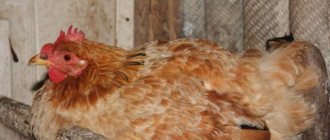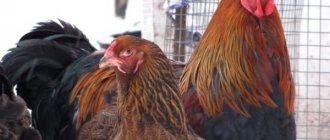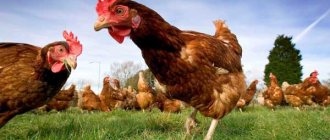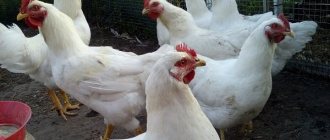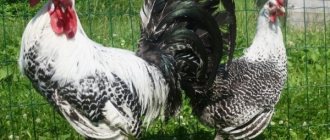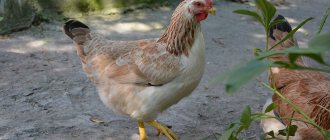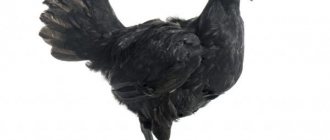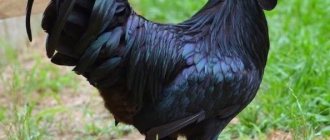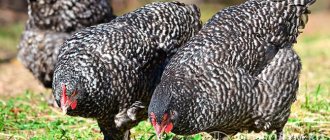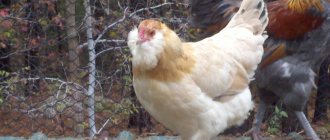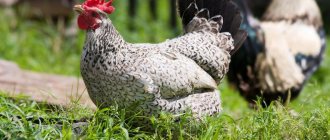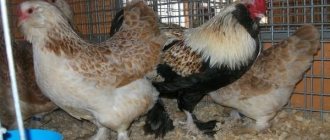Leghorn chickens are a highly productive egg-producing breed, the bird was bred in Italy. Today it is the basis of most egg-laying crosses and is actively used in poultry farming.
More than 20 varieties of the breed are known, differing in plumage color and productivity. Despite the long existence of the breed, Leghorns are still being improved today, and new species lines are appearing. From the article you will learn what is remarkable about the breed and the features of its breeding.
Description of the breed
Photo:
Leghorn chickens are unpretentious, so they can be found even in the coldest corners of the world.
Externally, these are large birds with the following characteristics:
- proportional wedge-shaped body;
- a thin and long neck on which is a small head;
- the comb is leaf-shaped, painted in a bright red hue. In roosters it is straight, in chickens it hangs to the side;
- the legs are long, in young birds they have a yellowish tint, turning white as the bird grows older;
- earlobes are white or blue, earrings are always red;
- the back is curved, the chest is convex;
- the eyes are small, the iris is yellow, orange or light brown;
- in chicks the skin is slightly yellow, in adults it is flesh-colored.
More than 20 colors of Leghorn plumage have been bred, but white birds are the most popular. Brown, partridge, motley and even black are also found on private plots. The birds have a calm, phlegmatic character and get along well with other inhabitants of the farm.
Age problems
Poultry productivity declines as it ages. Females older than 18 months. lay no more than 120 eggs per year, so their further maintenance becomes impractical.
In older chickens, the body's defense reactions decrease, which increases the risk of developing a number of diseases, which include:
- Infectious paralysis. The causative agent is considered to be a virus that affects the central nervous system and eyes. A tumor forms on the skin, and the disease affects the internal organs. An elderly individual refuses food, quickly loses weight, becomes blind and loses the ability to move. There is no specific treatment; the bird must be destroyed.
- Bronchitis . In older individuals, the reproductive organs are affected. The bird stops flying. The virus is transmitted by airborne droplets. The risk of infection in young animals is quite high. The bird may die from suffocation.
- Pseudo-plague. In an elderly laying hen, the pathology is asymptomatic. The functioning of the musculoskeletal system is impaired, the bird cannot absorb food. It is impossible to cure the disease; the hen dies within 48-72 hours.
To minimize the risk of infection in young animals, experts recommend sending poultry for slaughter upon reaching 18-20 months.
Origin story
Leghorn is a breed of Italian origin. They received their name only towards the end of the 20th century after productive chickens were brought to America.
It is believed that Leghorn comes from the word Livorno, the name of a large Italian port. After the active spread of the bird, work began on its selection; chickens were crossed with Minorcas and Japanese ornamental roosters.
It was then that Leghorn chickens received their signature white plumage. Birds arrived in Russia only in 1925, and chickens began to be bred on an industrial scale only in the 70s.
Today, the Leghorn breed is one of the most common breeds of egg-laying chickens in the world.
Price
The cost of roosters of this breed varies between 200-250 rubles. Growing chickens can be purchased for 150-180 rubles/piece. Laying hens are more expensive, their cost is 300-350 rubles. Leghorn chickens (by description and photo you can study the exterior of the subspecies) are considered the most popular breed of egg production. When buying a bird, you need to pay attention to its appearance: males and females should have dense plumage, uniform color and a strong beak. Healthy individuals have shiny eyes, without signs of clouding or inflammation of the sclera.
Varieties
It is believed that Leghorns today are no longer an independent breed, but a kind of genetic base for the formation of new species. In each country, active work is underway to develop new egg crosses and varieties of the breed.
There are more than 20 breeding factories operating in Russia alone. Only white and dwarf leghorns are the most popular.
White
The key species of the breed differs from other varieties in the snow-white color of its plumage; other colors on the body are a defect from the standard.
The bird does not lose productivity even under unfavorable conditions and can withstand severe frosts. It was white chickens that gave rise to all the other 20 shades of plumage, which is associated with an increase in demand for brown shells and the decorative appearance of birds.
Brown
They also have an egg production orientation and are distinguished by a beautiful golden-brown plumage color. They have pronounced sexual dimorphism; roosters can be distinguished not only by size, but also by the presence of long red-gold feathers on the neck.
It is acceptable to have black plumage, which in the sun has a green tint.
Cuckoo-partridges
This variety is often used for genetic work. Birds are highly adaptable and unpretentious in maintenance.
Unlike other species, Leghorns with this color are larger and can grow up to 4 kg. Chickens lay smaller eggs, but egg production is at a high level.
Golden
One of the most beautiful varieties of the breed. The plumage is painted in a rich golden color, the comb and earrings are red, and the earlobes are yellow. They are used only as ornamental birds, but egg production can reach 260 eggs per year.
Dwarf
This subspecies of the breed is called B-33. The weight of a rooster can reach only 1.7 kg, chickens are slightly less. Adults have white plumage, chicks are always yellow. The dwarf variety of the breed has an energetic temperament but is not aggressive towards other birds on the farm.
They are economical to maintain and are a real decoration of the site. But even among dwarf leghorns, egg production indicators are at the same level - a laying hen lays up to 250 eggs per year.
Content Features
Of all the Leghorn subspecies, the white ones are considered the most unpretentious. Poultry is raised in special cages or chicken coops. They feel equally at home in a cramped room with a small area or a spacious poultry house. If you plan to breed the breed on an industrial scale, you can use cages. It is important to remember that crowding increases the risk of developing various pathologies in young animals and adults.
To eliminate this factor, hormonal and antibacterial medications are added to the food (after consultation with a veterinarian). To maintain high egg production rates, specially comfortable conditions are created for laying hens. Individuals older than 18 months are subject to culling. Males and females are most often sent for slaughter.
Poultry house requirements
The poultry house in which it is planned to keep chickens and roosters must be properly equipped. Inside, drinkers, feeders, nests are installed and perches are secured. An important condition is to conveniently equip the chicken coop not only for the birds, but also for a person who can easily clean the room. Perches are understood as planed bars (cuttings, branches), assembled into a staircase-type structure and fixed above the floor. For 1 chicken there is up to 25 cm (roost area in length). There should be 30 cm of space between the structure and the wall.
A distance of 40-45 cm is left between the perches. Experts do not recommend installing multi-tiered structures - in this case, the birds will come into conflict with each other in order to occupy the highest place. A shield is installed under the perch onto which droppings will fall. It is preferable to place a sheet of smooth metal under the structure - it will be convenient to clean.
Mandatory elements include nests. Chickens should feel safe inside them. Place wooden boxes close to each other, no more than 3-4 in a row. In order for the hen to easily get into the nest, it is necessary to attach small ladders (2 boards connected by poles) across them. You can place the nests not far from the roost. The entrance should be small so that the chicken does not stay inside the structure for a long time. The roof is installed sloping.
Females prefer to lay eggs in the dark, so the area where the boxes are located should have adequate lighting. Egg receptacles are very popular among poultry farmers - these are special compartments into which eggs are rolled. It is necessary to choose the right flexible material (piece of rubber, plastic) that the egg could move away. The egg receptacle is installed behind the nest (just below the box). Straw and sawdust are poured onto the bottom of the structure to prevent the egg from breaking when rolling.
Several drinkers and feeders are installed indoors so that the birds do not conflict with each other for the best place. Lighting plays an important role: additional light sources must be installed in winter to maintain the productivity of the breed. Infrared lamps allow you to additionally warm up the room. Too harsh light can cause a panic attack in roosters or laying hens, so LED lamps are not installed inside the poultry house.
Walking requirements
Leghorn chickens (a detailed description and photos of the varieties are presented in the article) need regular walking. The most suitable place is considered to be a meadow or garden where grass grows. If there is asphalt around the poultry house, then you can equip a pen, which is called a “solarium”. It is fenced off from the poultry house with chain-link mesh. It must be at least 2 m high. To prevent the bird from flying away, its wings are clipped 2 times per season (every 2 months).
It is recommended to install a large feeder inside the pen so that all the chickens can eat at the same time. Fine gravel or pebbles are poured into the bottom of the structure. Feed and grain are given to the birds twice a day. Wet food quickly deteriorates in the fresh air, especially in the warm season, so it is necessary to monitor its condition.
The size of the pen directly depends on the number of livestock. If there are more than 30 birds in the house, then a solarium measuring 15x15 m is built. Birds are strictly contraindicated from staying in a draft for a long time. Solariums are built on leeward sides. Bushes are planted near the paddock to provide additional protection from the wind. Closed enclosures are usually built on the same platform as the chicken coop. Inside structures of this type, birds may not be afraid of predators.
Conditions for winter
To minimize the risk of developing diseases caused by temperature changes, experts recommend starting insulation of the chicken coop in late autumn.
Work should be carried out in several directions:
- ceiling;
- doors and windows;
- walls;
- floor.
Thermal insulation of the poultry house should begin from the bottom. First of all, bedding is placed on the concrete floor. It should be as dense and thick as possible.
Materials that can be used to insulate the floor inside the chicken coop:
- Sawdust or shavings . Waste from coniferous trees (fir, spruce, pine) is poured onto the floor. They contain essential oils that can have a disinfectant and healing effect. Coniferous sawdust maintains an optimal level of humidity indoors. The ratio of sawdust and shavings is 1:3.
- Straw . The material accumulates heat and retains it for a long time. The straw bedding should be made as thick as possible, at least 22-25 cm. Chickens quickly trample down the material, so 10 cm of straw is added to the floor once every 30 days.
- Peat . The material quickly absorbs moisture, which helps prevent the appearance of a putrid odor. The bird's paws remain warm for 3 months.
After the floor is insulated, they begin covering the walls. First of all, you need to seal the holes with tow or moss. Then lay a layer of insulating film, lay out the boards in 2 rows and apply an insulating solution. You can also cover the walls with foam plastic. Doors and windows are insulated using a transparent thick film. The cracks are plugged with rags. The ceiling is laid with mineral wool and covered with thermal insulation film. For the winter, you can install an additional heating system (stove or radiators).
Feeding hens
When breeding Leghorn hens, you must adhere to several basic rules.
Absolutely forbidden:
- Underfeed the bird . The laying hen's diet must be balanced. Nutritional deficiency negatively affects productivity: the body of a chicken suffering from malnutrition is not able to form a shell. The female will lay small eggs.
- Overfeed the bird . Systematic overeating can cause obesity. In this case, the egg gets stuck in the passage, which can lead to the death of the individual. The growth of the fat layer leads to a decrease in egg production.
Every year, a chicken should consume:
- greens - 15 kg;
- compound feed - 38-40 kg.
Feed for laying hens per day:
- greens - 50 g;
- dry food - 130-170 g.
Laying hens should receive a balanced feed that contains:
- fiber - up to 7%;
- carbohydrates - up to 75%;
- fats - up to 5%;
- proteins - up to 20%.
The food intake in winter is increased by 15-20% so that the bird can replenish the energy spent on heating the body.
Caring for young animals
When caring for young animals, you must adhere to a number of rules:
- Chicks under 15 days old should not be left unattended;
- Periodically during the day it is recommended to supervise the young animals to avoid attacks by predators.
- Open containers with water should not be left inside the poultry house to prevent the chickens from drowning;
- Chickens are separated from roosters at the age of 30 days;
- It is recommended to isolate weak chickens from the rest of the livestock, providing them with a comfortable, warm, dry place;
- To avoid the death of young animals, it is necessary to carefully monitor the temperature conditions inside the room. Having frozen, the chickens climb on top of each other, trying to keep warm, so the bird below may die from suffocation;
- Young animals are allowed out for walks only in calm, warm, dry weather;
- Drinkers and feeders must be cleared of food debris. Every 4-6 days, equipment is cleaned and disinfected;
- The diet of young chickens should be dominated by mineral feed (ground shells, chalk), young greens (nettle, alfalfa, clover, green onions);
- Young animals need to be provided with plenty of fluids. The water is changed every 2-3 hours.
It is strictly forbidden to overfeed young chickens. They are given food 3-4 times a day and make sure that the mash is eaten without any residue.
Nutrition of growing birds
Chicks over 30 days old are considered juveniles. They can be walked together with adults. The chicken independently finds beetles, earthworms, plant seeds and fresh herbs. If walking is carried out in a solarium, then vegetables and greens must be included in the diet of the growing bird. The mass fraction of the latter makes up 1/3 of the total diet.
Are young animals given whole ground grain:
- oatmeal;
- corn;
- barley;
- wheat
Legumes (small beans, chickpeas, crushed beans) can be included in the diet. In addition to grain, grown-up chickens are given boiled or fresh vegetables, bran, cake and mixed feed. It is necessary to add minerals to the mash and dry food to help strengthen musculoskeletal tissue.
These include:
- salt;
- shell rock;
- lime;
- fish or bone meal.
The bird must always have clean water. You can add fine gravel to the bottom of the feeder to stabilize digestion.
Price
The cost of young birds depends on the region, farm, and the color of the bird’s plumage. On average, the price for laying hens is 500 rubles, roosters are more expensive - from 700 rubles.
Hatching eggs are cheaper, the price tag starts from 75 rubles. The breed has a high hatchability rate, but before purchasing eggs, you must check them with an ovoscope for defects.
Leghorn diseases
Individuals of this breed have good immunity and rarely get sick; the only thing that often disturbs the birds is loud noise. The chickens become extremely aggressive towards each other and towards people, and stop laying eggs.
Chickens need to be prevented from getting diseases. Vaccines against infections and tuberculosis are recommended. It is necessary to keep the birds' home clean and prevent the development of microbes, and limit contact with other animals.
If birds live in cages, due to lack of sun and low mobility, they are more prone to illness. For prevention purposes, it is recommended to give them:
- potassium iodide;
- calcium chloride;
- choline chloride
Households often prefer to give up medications and strengthen the birds’ bodies using traditional methods. Namely:
- salo;
- vodka;
- black pepper (pea-shaped);
- ginger or aloe.
In winter, to avoid vitamin deficiency, feed onions and garlic. If it turns out that one of the individuals is sick, it must be immediately isolated until complete recovery, so that the others do not become infected.
Reviews
Leghorn chickens have received the most positive reviews from poultry farmers. The breed is distinguished by high levels of egg productivity, unpretentiousness and adaptability to living conditions.
Birds are actively used on industrial and private farms as genetic material for breeding new highly productive crosses.
Among the disadvantages are the lack of brooding instinct and the high price of high-quality young animals. It should be remembered that in the second year egg production decreases, so the population of laying hens should be updated in a timely manner.
Owners' opinion
Most breeders have positive reviews of the Leghorn breed. This is due not only to high productivity, but also unpretentiousness.
Svetlana , 35 years old, Rostov-on-Don
I have experience raising many breeds of chickens. Leghorns are the best. I raise them in an insulated chicken coop, to which is attached an aviary for walking outside. I feed mash, grain, boiled vegetables and fruits. In summer they get greens. In winter, I turn on the light in the chicken coop in the morning and evening. Egg production does not decrease.
Igor , 42 years old, Moscow
I have been keeping leghorns for eggs for more than 10 years. I give different foods. As feeding - protein, shell and chalk. The egg production of the bird remains high for 2.5-3 years.
Productivity, egg production
Beginning in the late 19th century, selection for Leghorns was carried out to increase egg production and reach sexual maturity earlier. On average, roosters weigh 2.5-2.7 kg, chickens weigh less - up to 1.9 kg.
The meat of this breed is not of high quality, it is very dry and bony. Egg production is one of the highest among purebred breeds; the annual number of eggs varies from 160 to 300 depending on the age of the bird and conditions of detention.
The weight of the egg reaches 65 g, the shell is very strong and white. Oviposition begins at 17-18 weeks of life, and from the second year the indicators gradually decrease.
Advantages and disadvantages
The Leghorn breed, like all species, has its advantages and disadvantages. Among the advantages are:
- Rapid onset of sexual maturity and high egg fertilization rate;
- Good rates of hatching chicks (about 80% survival rate);
- High productivity of laying hens;
- Large egg size;
- Economical feed consumption;
- Unpretentiousness to climatic conditions, individuals are friendly and calm;
- They quickly adapt to new conditions of detention.
The main disadvantages of the breed:
- Slow decline in egg production over the years;
- The breed is not a meat breed and is not well suited for human food;
- Laying hens cannot hatch eggs on their own, since their maternal instinct is poorly developed;
- Birds cannot tolerate bright light and noise.
Individuals of this breed get sick very rarely. Preventative measures must be taken to avoid illness. Your veterinarian will help you decide how to treat them. It is contraindicated for birds to be in a noisy room, otherwise they will begin to fight in hysterics.
Breeding
Laying hens of the Leghorn breed completely lack the brooding instinct, so for breeding you need to purchase raised young animals or use hatching eggs.
Chickens have a high survival rate and have strong immunity. If you plan to raise young birds yourself, then you need to prepare a brooder - a room for keeping birds in the first weeks of life.
For a small herd, a box or enclosure equipped with a heat source and lighting is suitable.
How to keep the Leghorn breed?
Although these birds are undemanding to the conditions of their keeping, they should not be neglected. After all, proper care will significantly increase the efficiency of the bird. So, let's figure out where and under what conditions it is necessary to keep the Leghorn breed.
Important! Leghorn chickens can be kept in aviary cages that are quite spacious. Such content is most often used in industry.
Setting up a chicken coop
According to many poultry farmers, this breed of chicken does not require special conditions, the main thing is that they are protected from loud sounds and bright light, which can cause stress in birds. Even a barn or other non-residential premises can be suitable as a chicken coop. The room for this breed should be quite spacious, as cramped space can cause illness in birds.
Good adaptation allows you to easily endure winter both in the southern and northern regions. When arranging the place of detention, special attention must be paid to the absence of drafts, and also to avoid sudden jumps and drops in temperature below +5ºС. To eliminate drafts and maintain a moderate climate in the chicken coop, insulating the walls and ceilings will help. Using high-quality insulating material will allow you to significantly save on heating costs.
If the walls and ceiling can be sheathed, then thick underlayment must be used to insulate the floor. Straw, sawdust or hay are suitable for this. The thickness of such flooring should be at least 50 cm. This will protect the flock from various diseases and maintain high egg production. In winter, it will be a good protection against the cold. As an overnight place for chickens, it is necessary to arrange reliable and comfortable perches that can be easily grasped.
Specifics of maintenance and care
The White Leghorn is distinguished by its unpretentiousness, adaptability and ability to acclimatize to almost any living conditions.
It is permissible to raise birds using the floor or cage method; in a small yard it is recommended to equip a spacious walking area.
On industrial farms, Leghorns are raised only in cages, which increases the risk of developing diseases. To avoid outbreaks of infection, vaccinations are carried out and antibiotics are added to the feed.
The requirements for keeping this breed are the same as for other representatives of the egg-producing type.
An important requirement is to limit noise, since during the period of active egg laying, laying hens are very anxious and afraid of any loud sounds. This leads to attacks of hysteria, and the birds' productivity is significantly reduced.
Regardless of the method of keeping, the entire flock should be provided with sufficient space; usually the chicken coop is planned at the rate of 3-4 individuals per 1 m2.
It is necessary to have drinking trays (100x120 mm), as well as several feeders. For birds, you need to equip perches for sleeping and nests for laying hens. The maximum humidity in the room should not exceed 70%, the optimal temperature is 12-16°C.
Are Leghorn laying hens profitable in Russia?
As practice shows, leghorns, in fact, in each country, the breed is represented by several intra-breed types, ... lay equally well and show excellent results in private households, and on small farms, and in industrial poultry farms.
From a commercial point of view, the characteristics of Leghorn chickens. In fact, in each country the breed is represented by several intra-breed types, ... is simply ideal: they eat little, lay eggs very well, and do not require any extra special conditions or feed. Thus, the question of the profitability of leghorn breeding depends only on the ability to organize sales of products, since there are no problems with achieving the optimal cost of production.
However, it should be taken into account that the meat yield from Leghorn chickens. In fact, in each country the breed is represented by several intra-breed types, ... absolutely minimal. In large-scale production, this is not a particular problem, since small Leghorn carcasses can be processed for the production of the same dog food. But for a private household, where they want to get not only eggs from chickens, but also a reasonable amount of meat, Leghorns, in fact, in each country the breed is represented by several intra-breed types, ... may not be the optimal option. However, to obtain meat at home, you can always use, along with Leghorns, also meat broilers, or simply a meat breed.
Feeding
There are no special feeding requirements for Leghorns. Chickens of this breed have a poor appetite, which allows them to save on feeding. However, you should be careful about the quality of food.
To maintain a high level of egg production, usually only feed is used that contains all the necessary components.
It is recommended to diversify the diet with fresh herbs in summer, vegetables and straw in winter. Every day you need to add chalk, slaked lime and shellfish to the food to form the shell. To maintain egg production, hens are also given vitamin supplements and high protein foods.
The average daily amount of feed should be 65-75 g per bird; food is best divided into two meals. In addition, there should always be sufficient fresh water in the chicken coop.
Chickens up to 14 days of age are kept in a separate room, gradually transferring them to an adult diet. To avoid problems with egg production, from the 6th day onwards, chicks should be offered shellfish, feed chalk or crushed shells. The diet of chicks is the same as for other breeds.
Diet of adult chickens
Starting from the third week of life, the chicks are transferred to an adult diet.
Laying hens can be given:
- grain feed;
- bone meal;
- vegetables;
- roots;
- feed chalk;
- green mass.
Grain is given to the birds in the morning and evening. At lunch, you should feed your chickens a mash containing chopped grass and vegetables. Protein supplements and vitamin-mineral complexes should be regularly introduced into the diet.
Grain feed for laying hens.
Diseases and their treatment
In general, Leghorns are a disease-resistant breed. In crowded housing or regular exposure to noise, laying hens may experience attacks of mass noise hysteria. The birds begin to scream heart-rendingly, hit the walls, and attacks of causeless aggression occur. This leads to injuries from the sharp corners of the cages, injury to the limbs and decreased productivity.
Adult chickens often have problems with the oviduct - it becomes inflamed and falls out (salpingitis). As a rule, this pathology develops starting from 2 years of life.
The disease not only causes severe discomfort and pain to the bird, but can also lead to infections. If treatment is not started in time, there is a risk of vitelline peritonitis - inflammation of the abdominal cavity.
Regardless of the size of the herd, you should regularly clean the feeders and change the bedding. At least twice a year, the chicken coop is deratized and treated for helminths.
In industrial farms, all birds must be vaccinated against major diseases (infectious bronchitis, salmonella, adenovirus, coccidiosis).
Chick care
Leghorn chicks hatch at 21 days. They are left in the incubator until their fluff dries out. The chicks are then transferred to a nursery. For the latter, you can use, for example, a large cardboard box.
In most cases, small Leghorn chickens, like chicks of any other breed, are fed with cottage cheese and boiled yolk. However, some poultry farmers have recently abandoned this practice, considering such food for chickens, even very small ones, to be unnatural. Instead of eggs and cottage cheese, they advise feeding chickens with “Start for Laying Hens” food specially designed for them. Since chicks eat very little, purchasing balanced food, of course, will not cause any special expenses. You can also feed your chickens finely cracked corn, wheat and oat kupa.
In the first ten days, the chicks are fed 5-6 times a day. By the month, the frequency of feedings is reduced to three times. From the age of four days, chicks begin to be given finely chopped greens, mixing them with the main food. It is also very useful for small chickens to be given finely crushed eggshells. On the fifth day, you can start adding a little chalk to your food.
One-month-old chickens can already be given potatoes, carrots and beets. White Leghorn chickens are not particularly fastidious birds. But following the rules for creating a “menu” for chicks is very important.
This is especially true for the diet of Dwarf Leghorn chickens. If there are too many proteins on the “menu,” the chicks’ legs will curl and they will die.
When raising small chickens, it is very important to maintain the correct temperature conditions. In the first five days, the chicks are kept at a temperature of 30-35 degrees. By the age of two months it is gradually reduced to 16-18 grams.
In the first 7 days of a chick's life, the nursery should be illuminated for at least 20 hours a day. Subsequent weeks – 18 hours. Chicks can be released for walking starting from the age of one week, in a place protected from sunlight and for a very short time. Chicks can be released for walks all day starting from the eighth week of life.
Photos
In the following photo you can see several individuals of both roosters and laying hens of the White Leghorn breed in one of the farms:
Photo of a white Leghorn hen in hand:
A beautiful specimen of a rooster walking in the garden:
There is already a larger farm here. The chickens seemed to come to take photos:
Male and female Partridge Leghorn, or as it is also called “Italian Partridge”:
Where is it better to keep: in a cage or on a walk?
Chickens are active and emotional, and due to stress they stop egg production for 10-14 days. It is recommended to keep Leghorns in a barn with a walk that has a partial roof. Due to the ability of chickens to fly and the desire to develop a new territory, the height of the fence for their walking is needed 150 cm, and optimally 200 cm. Cage housing is allowed for industrial breeding of poultry, when it is used for several months, and egg production is stimulated by premixes. For a homestead, this method of maintenance is undesirable. When kept in cages, Leghorn-based hybrids are chosen.
The bird is not aggressive towards humans. Roosters may attack their owner if they perceive him as a threat to the hens, and usually limit themselves to intimidation. Aggression between chickens occurs extremely rarely and is rather the exception. Leghorns are quite tolerant of other breeds of chickens. May be kept with other poultry.
